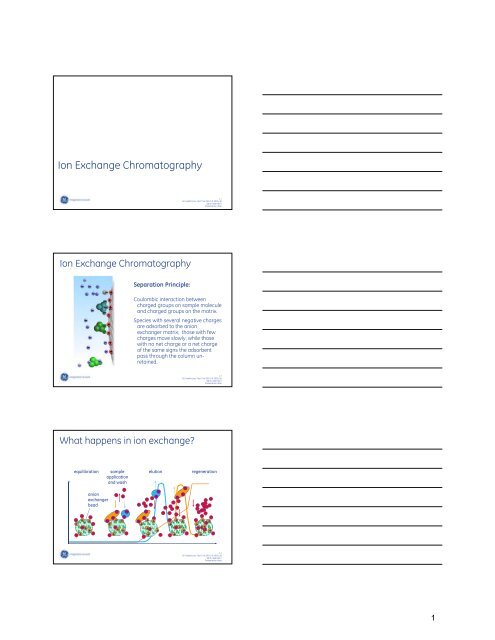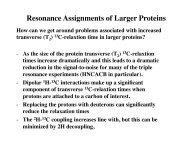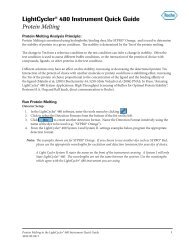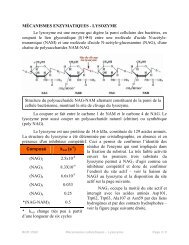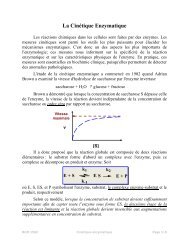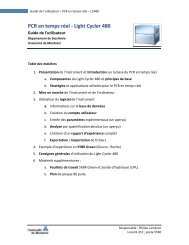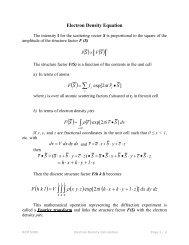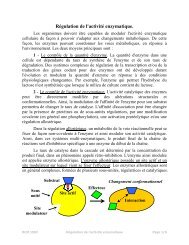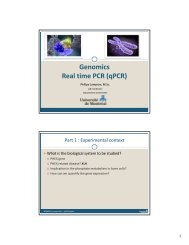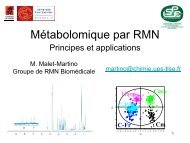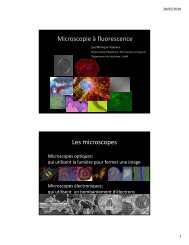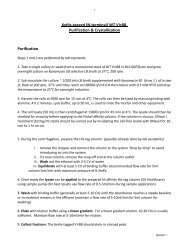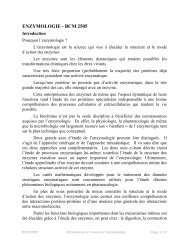Ion Exchange Chromatography
Ion Exchange Chromatography
Ion Exchange Chromatography
- No tags were found...
Create successful ePaper yourself
Turn your PDF publications into a flip-book with our unique Google optimized e-Paper software.
What happens in ion exchange?equilibration+--++--- + +-+-anionexchangerbead4/GE Healthcare, Fast Trak DEV1 © 2005, allrights reserved /Presentation dateWhat happens in ion exchange?sampleapplicationand wash---- -+++- + +-+-5/GE Healthcare, Fast Trak DEV1 © 2005, allrights reserved /Presentation dateWhat happens in ion exchange?elution-- --- - - - -- - - -- -- --+ + + -+ +++ - + - +++- - -+ -6/GE Healthcare, Fast Trak DEV1 © 2005, allrights reserved /Presentation date2
What happens in ion exchange?regeneration-- ---- - -- + -+ -+- - +- +-+-7/GE Healthcare, Fast Trak DEV1 © 2005, allrights reserved /Presentation date8/GE Healthcare, Fast Trak DEV1 © 2005, allrights reserved /Presentation date<strong>Ion</strong> <strong>Exchange</strong> <strong>Chromatography</strong> (IEX)The ideal matrix:– Hydrophilic– Large pore size– Spherical (mono-sized) particles– Rigid– Chemically stable9/GE Healthcare, Fast Trak DEV1 © 2005, allrights reserved /Presentation date3
Functional groups used on ion exchangersCation exchangersFunctional groupCarboxymethyl (CM) -OCH 2 COO -Sulphopropyl (SP) -CH 2 CH 2 CH 2 SO -3Methyl sulphonate (S) -CH 2 SO -3Anion exchangersFunctional groupDiethylaminopropyl (ANX) -CH 2 CHOHCHH 2 NH + (CH 2 CH 3 ) 2Diethylaminoethyl (DEAE) -OCH 2 CH 2 N + H(CH 2 CH 3 ) 2Quaternary aminoethyl (QAE) -OCH 2 CH 2 N + (C 2 H 5 ) 2 CH 2 CH(OH)CH 3Quaternary ammonium (Q) -CH 2 N + (CH 3 ) 311 /10 /GE Healthcare, Fast Trak DEV1 © 2005, allrights reserved /Presentation dateStrong and weak ion exchangersWeak anionexchangerWeak cationexchangerWeak ion exchangers:capacity varies with pHStrong anionexchangerStrong cationexchangerStrong ion exchangers:capacity is constant over awide range of pHGE Healthcare, Fast Trak DEV1 © 2005, allrights reserved /Presentation dateEffect of pH on chargeRCOOHNH+ 3hydrogen gainedlow pHpositive chargeRCOO-NH+3high pHnegative chargehydrogen lostR NH 2COO -12 /GE Healthcare, Fast Trak DEV1 © 2005, allrights reserved /Presentation date4
Titration curves+acid isoelectric point alkalineexcess positive charge balanced positive and negative charge excess negative chargeoverall charge on protein-COOHR NH+ 3pH 3 pH 10COO -R NH 2COO-R NH+ 3the overall charge on a protein depends on pH13 /GE Healthcare, Fast Trak DEV1 © 2005, allrights reserved /Presentation date<strong>Ion</strong> <strong>Exchange</strong> <strong>Chromatography</strong> (IEX)Selectivity• Electrophoretic titration curvesRCOOHNH+ 3A A A A+Cation exchange04 10pHA A AAnion exchangeAR NH 2COO -14 /GE Healthcare, Fast Trak DEV1 © 2005, allrights reserved /Presentation dateIsoelectric Point -Electrophoretic Titration Curves1 rhuMAb pI 8.5 - 8.8 1 rhuMAb pI 8.5 - 8.82 BSA pI 4.8 2 Carbonic Anhydrase II pI 5.93 ß-Lactoglobulin A pI 5.215 /GE Healthcare, Fast Trak DEV1 © 2005, allrights reserved /Presentation date5
pH operating window for target proteinChoice of Cation or Anion <strong>Exchange</strong>rNet charge of target protein is positive ornegative depending upon the pH of thesurrounding solution.This allows for the use of either cation oranion exchangers in the purification process.6.0 6.5 7.0 7.5 8.0pHConsider Protein Stability WindowThe target protein may only be stable over asmall range of pH’s.This range must be determined in order todevelop a purification protocol that maintainsthe biological activity of the target molecule.16 /GE Healthcare, Fast Trak DEV1 © 2005, allrights reserved /Presentation dateAdsorption of protein over timeBSA adsorption to SP Sepharose Fast Flow17 /GE Healthcare, Fast Trak DEV1 © 2005, allrights reserved /Presentation dateBreakthrough Curve1.0C/C 0C = concentration of solute in column effluentC 0 = concentration of solute in sample0.5Volume18 /GE Healthcare, Fast Trak DEV1 © 2005, allrights reserved /Presentation date6
“Real world” binding capacityConc..V AA 280ActivityC 0Start WashVolume19 /GE Healthcare, Fast Trak DEV1 © 2005, allrights reserved /Presentation date<strong>Ion</strong> <strong>Exchange</strong>Optimization-pHSelectivity change as a function of pHfor an anion exchanger.Separation ofChymotrypsinogen A (pI 9.0)Cytochrome C(pI 9.4)Lysozyme (pI 11.0)Transferrin (pI 6.0)Ovalbumin (pI 4.7)ß-Lactoglobulin (pI 5.1)Column: Mono Q.20 /GE Healthcare, Fast Trak DEV1 © 2005, allrights reserved /Presentation dateCharge Properties of Mab & Major ImpuritiesPolyclonal antibodies from serumMonoclonal antibodies pI 5 - 94 5 6 7 8 9 10 pIAlbuminpI 4.9TransferrinpI 5.2 - 6.1a2 Macroglobulin from serumpI 4.1 - 4.97 isoformsMw 820 kDPhenol red binds to anion exchanger21 /GE Healthcare, Fast Trak DEV1 © 2005, allrights reserved /Presentation date7
HiTrap columns for fast screeningSlightly differentselectivitiesdespite same QligandCapto QQ Sepharose XLQ Sepharose Fast FlowDEAE Sepharose FastFlowANX Sepharose 4 FastFlow (high sub)22 /GE Healthcare, Fast Trak DEV1 © 2005, allrights reserved /Presentation dateCation <strong>Exchange</strong> Capture ofIgG from Cell Culture Supernatant.Sample:1.5 liters MAb in Buffer #1Column:S Sepharose Fast F low;16 ml (26 x 30 mm)Flow rate:sample application and wash at 300 cm/h;elution at 6 cm/hEluate:collected in 42 mlBuffers:1 Wash20 mM trisodium citrate-HCl, pH 5.3.2 Elution20 mM trisodium citrate- HCl140 mM NaCl, pH 5.03 Wash0.1 M NaOHOD 2801.51.00.5MAb1 2 3 10.5 1.0 1.5 2.01:wash; 2:elution; 3:washvolume, liters23 /GE Healthcare, Fast Trak DEV1 © 2005, allrights reserved /Presentation dateCation <strong>Exchange</strong> Capture of IgM fromHybridoma Cell CultureColumn: SP Sepharose Fast FlowSample: Mouse IgM fromhybridoma cell cultureStart Buffer: 75 mM Tris-HCl,pH 8.0Elution buffer: 75 mM Tris-HCl,1 M NaCl, pH 8.0A 280%0.10 IgM100A 280Column: Superdex 200 HR 10/30Sample: 0.2 ml from previous runBuffer: 50 mM sodium phosphate,0.15 M NaCl, pH 7.8Flow rate: 1 ml/minIgM0.050.0550InjectTime0 10 20Elution volume in24 ml/GE Healthcare, Fast Trak DEV1 © 2005, allrights reserved /Presentation date8
New media on the block….the Capto TM25 /GE Healthcare, Fast Trak DEV1 © 2005, allrights reserved /Presentation dateThe latest platform from GEHCSTREAMLINECNBr-SepharoseSepharose Big BeadsSepharose FFSepharose XLSepharose Sepharose CLMabSelect XtraSepharose HPMabSelectSuperdexSuperoseCapto1960 1970 1980 1990 2000receptorsplasma IgGnative insulinrDNA proteinsmonoclonal recombinantantibodies vaccinesplasmidsvirus26 /GE Healthcare, Fast Trak DEV1 © 2005, allrights reserved /Presentation dateCapto base matrixHigh flow agarose – combininghigh rigidity with all the goodproperties of agarose• hydrophilic and neutral “protein friendly”• chemically stable CIP using NaOH• low material content and open pore structure high capacity and fast mass transfer• now adding high rigidity to these features27 /GE Healthcare, Fast Trak DEV1 © 2005, allrights reserved /Presentation date9
The new Capto platform• Designed for the next generation BioProcesses• Based on the novel high flow agarose platform– Also used for the MabSelect family• Capto media allows for:– Faster purification– More flexible process design– Cost effective processes28 /GE Healthcare, Fast Trak DEV1 © 2005, allrights reserved /Presentation dateCapto Q and Capto SStrong ion exchangerBase matrixHigh flow agarose90 µm (average)+ +Surface extenderAnimal free dextranS LigandSulphoethylO -SO 3OOH+NQ LigandQuaternary ammonium29 /GE Healthcare, Fast Trak DEV1 © 2005, allrights reserved /Presentation dateSurface extenders• Improved– Protein binding capacities– Mass transfer• Proven for <strong>Ion</strong> <strong>Exchange</strong> Media• Animal free dextran– Used as surface extender for Capto S andCapto Q30 /GE Healthcare, Fast Trak DEV1 © 2005, allrights reserved /Presentation date10
Surface extenders‣ Increased equilibrium capacity‣ Increased mass transferUnmodified agaroseBase matrixDextran modified agaroseBase matrixSchematic drawingnot at scale31 /GE Healthcare, Fast Trak DEV1 © 2005, allrights reserved /Presentation dateConfocal microscopyEnhanced protein uptake (mass transfer) for CaptoSepharose Fast FlowCaptoTime32 /GE Healthcare, Fast Trak DEV1 © 2005, allrights reserved /Presentation dateHigh flow rates and low backpressureat large-scalePressure/flow specification:>700 cm/h in 1 m diametercolumn, 20 cm bed height, below3 barCapto Q and Sepharose 6 Fast Flow inBPG 300, 20 cm bed height33 /GE Healthcare, Fast Trak DEV1 © 2005, allrights reserved /Presentation date11
High dynamic binding capacityQB10% BSA (mg/mL)160140120100806040Capto QQ Sepharose FF2000 500 1000 1500Mobile phase velocity (cm/h)Bed height: 10 cm34 /GE Healthcare, Fast Trak DEV1 © 2005, allrights reserved /Presentation dateHiTrap columns for fast screeningSlightly differentselectivitiesdespite same QligandCapto QQ Sepharose XLQ Sepharose Fast FlowDEAE Sepharose FastFlowANX Sepharose 4 FastFlow (high sub)35 /GE Healthcare, Fast Trak DEV1 © 2005, allrights reserved /Presentation dateEffect of conductivity on DBCDBCCapto S• Highest DBC obtained atlow conductivity• Higher DBC on Capto Sthan on SP Sepharose Fast Flow.• Non-traditional behaviourcan be found with Capto SConductivitySP Sepharose Fast Flow36 /GE Healthcare, Fast Trak DEV1 © 2005, allrights reserved /Presentation date12
Effect of pH on DBC on Capto SThe DBC curves are shifted towards lower conductivities withhigher pH (closer to the Ip = lower protein net charge)DBCLow pHDBCHigh pHLow pHHigh pHConductivityConductivity37 /GE Healthcare, Fast Trak DEV1 © 2005, allrights reserved /Presentation dateNon-traditional behaviourExclusion hypothesis – low conductivity• Strong binding at pore opening• Reduced pore accessibility due to:– steric hindrance– charge repulsionDBC+ +++ + +++-- - -- +++---+ - -++-- - +++++++-- + +- -++-++--++- -+ -++-+- + -+++Conductivity++++38 /GE Healthcare, Fast Trak DEV1 © 2005, allrights reserved /Presentation dateNon-traditional behaviourExclusion hypothesis – optimal conductivity• Equilibrium shifted towards unbound state• Facilitated mass transport into the porenetwork• Reduced thickness of electric double layerDBC+ +++ + +++-- - -+ - ++--+-+ - --- - ++++++Conductivity++-- + +- -++ + + -++ + +++ --++ ++- -++ ++ -++-+- + +++ +++ -++39 /GE Healthcare, Fast Trak DEV1 © 2005, allrights reserved /Presentation date13
Non-traditional behaviourExclusion hypothesis – higher conductivity• Equilibrium capacity reduced• “elution mode”DBC+ +++ + +++-- - -- +++--++-+ - -++-- - +++Conductivity+++-- +- -+- +-+-+- -+ --- +-++++ +40 /GE Healthcare, Fast Trak DEV1 © 2005, allrights reserved /Presentation date++++Traditional and non-traditionalbehaviourDifferent proteins show different behaviourDBC 250200150alpha-ChymotrypsinpH 4.25pH 4.75pH 5.25DBC 150100ConalbuminpH 4.25pH 4.75pH 5.25100505000 5 10 15 20Conductivity (mS/cm)00 5 10 15 20Conductivity (mS/cm)41 /GE Healthcare, Fast Trak DEV1 © 2005, allrights reserved /Presentation dateCapto MMC: multimodal chromatography42 /GE Healthcare, Fast Trak DEV1 © 2005, allrights reserved /Presentation date14
General ConceptTraditional and Multimodal LigandsHIC/RPC(Hydrophobicity)<strong>Ion</strong> exchange(Charge)Affinity(Biorecognition)43 /GE Healthcare, Fast Trak DEV1 © 2005, allrights reserved /Presentation dateWhat is Capto MMC?Multimodal ligand• allows binding of proteinsat high conductivity• gives a new selectivity… on a rigid Capto matrix• high volume throughput• flexibility in process design44 /GE Healthcare, Fast Trak DEV1 © 2005, allrights reserved /Presentation dateThe MMC ligandOffers multiple types of interactions• ionic interaction• hydrophobic interaction• hydrogen bonding45 /GE Healthcare, Fast Trak DEV1 © 2005, allrights reserved /Presentation date15
Binding is independent of conductivitycomparing three different proteins46 /Capacity values correspond to data at GE 1 min Healthcare, residence Fast Trak DEV1 time © 2005, allrights reserved /Presentation dateExpanding the flexibilityCapto MMC gives flexibility in terms of conductivity of thestart materialCapacity values correspond to data at 1 min residence time47 /GE Healthcare, Fast Trak DEV1 © 2005, allrights reserved /Presentation dateNew selectivityChlorite dismutase in Escherichia coli homogenateConductivity: 7.5 mS/cmGreen curve representsspecific adsorption ofchlorite dismutase at400 nm48 /GE Healthcare, Fast Trak DEV1 © 2005, allrights reserved /Presentation date16
Binding and elution conditionsDue to the multimodal properties of the MMC ligand,binding and elution conditions deviate from thoseof classical IEX mediaTherefore optimization of these conditions contributesignificantly to the overall productivity andeconomical viability of the capture step49 /GE Healthcare, Fast Trak DEV1 © 2005, allrights reserved /Presentation dateCapto MMC – salt elutionF(ab’)2, Ip 7.2, Mw ~100 kDa1 M NaOHAcetate buffer, pH 5,1 M NaClTris buffer, pH 8.5,1 M NaClAcetate buffer, pH 5,0.15 M NaCl0 100 200 300 400 500 600 700ml50 /GE Healthcare, Fast Trak DEV1 © 2005, allrights reserved /Presentation dateCapto MMC – salt elution and pHFab, Ip 8.6, Mw ~50 kDa1 M NaOHphosphate buffer, pH 6,1 M NaClTris buffer, pH 9.61 M NaClphosphate buffer, pH 60.15 M NaCl0 50 100 150 200 250 300 ml51 /GE Healthcare, Fast Trak DEV1 © 2005, allrights reserved /Presentation date17
Cation exchangersIsoelectric point vs loading pHChargeTradional cation exchangeChargeCapto MMCIpIppHpHOHOHO O SOO O52 /GE Healthcare, Fast Trak DEV1 © 2005, allrights reserved /Presentation dateMultimodal <strong>Ion</strong> <strong>Exchange</strong><strong>Chromatography</strong> - Capto adhereOHOHO O N + OHN-Benzyl-N-methylethanolamine• Designed for post protein A purification of MAbs at process scale for efficientremoval of high contaminant levels from high titer feedstocks• Strong anion exchange multimodal ligand• Based on the rigid Capto base matrix• Operated in removal mode (flowthrough mode)53 /GE Healthcare, Fast Trak DEV1 © 2005, allrights reserved /Presentation dateMultimodal Anion <strong>Exchange</strong> Polishing onCapto adhereYield 92%HCP In: 55 ppmOut: 7.5 ppmProt A In:
<strong>Ion</strong> <strong>Exchange</strong>rsIsoelectric point vs loading pHChargeTradional anion exchangeChargeCapto adhereIpIppHpHOHOHO O N + OH55 /GE Healthcare, Fast Trak DEV1 © 2005, allrights reserved /Presentation dateGradient examplesResin Alternative Buffer A Buffer BCapto MMC pH 4.5 to 7.850 mM Na-acetate, 25 mMNa-phosphate, pH 4.550 mM Na-acetate, 25 mMNa-phosphate, pH 7.8pH 4.5 to 950 mM Na-acetate, 25 mMNa-phosphate, 25 mM Tris,pH 4.550 mM Na-acetate, 25 mMNa-phosphate, 25 mM Tris,pH 9pH 4 to 7.8 + salt gradient50 mM Na-acetate, 25 mMNa-phosphate, pH 4.550 mM Na-acetate, 25 mMNa-phosphate, pH 7.8, 1 MNaClCapto adhere pH 7.8 to 4.0pH 10 to 6.525 mM Na-phosphate + 50mM Na-Na-acetate pH 7.850 mM glycin + 25 mM Nafosfat+ 25 mM Tris, pH 1025 mM Na-phosphate + 50mM Na-Na-acetate pH 4.050 mM glycin + 25 mM Nafosfat+ 25 mM Tris, pH 6.556 /GE Healthcare, Fast Trak DEV1 © 2005, allrights reserved /Presentation dateScreening of elution conditionsTo consider• Other salts than NaCl can be tested. How different salts will affect the elutionbehaviour is difficult to predict and will be sort of trial and error. The fact that NH4Clgave better recovery results for Capto MMC than NaCl is probably due to adisplacement effect (NH4 smaller than Na).Effects of Salts on Protein-Surface Interactions: Applications for Column <strong>Chromatography</strong> (2007) Tsumoto et al., J Pharm Sci, 96,1677-1690• Hydrogen bonding disruptors: Urea/Gua HCl or organic modifiers can be tested if itis ok in the process•A rapid change in pH in the column (from loading/wash pH to elution pH) will givemore narrow elution peaks. A good buffering capacity (concentration of the bufferspecies) should therefore be ensured.• Capacity utilization may affect the recovery/purity and therefore this should also beverified when the initial experiments with small loads have been done.•The loading condition may affect the ease of elution of the protein.57 /GE Healthcare, Fast Trak DEV1 © 2005, allrights reserved /Presentation date19
Summary58 /GE Healthcare, Fast Trak DEV1 © 2005, allrights reserved /Presentation date<strong>Ion</strong> <strong>Exchange</strong> <strong>Chromatography</strong> (IEX)When to use in process chromatography:– At any step in a downstream procedure– Especially useful as an early step59 /GE Healthcare, Fast Trak DEV1 © 2005, allrights reserved /Presentation date<strong>Ion</strong> <strong>Exchange</strong> <strong>Chromatography</strong> (IEX)Advantages:• broad applicability• relatively low cost• high capacity• high speed (> 300 cm/h)• sample volume not limiting• high resolution(increased with High Performancemedia)• nucleic acid removal• endotoxin removal• no regulatory issues– Low toxicity & ligand leakageLimiting factors:• binding kinetics– low conc. limits binding capacity• matrix properties• requires low conductivity60 /GE Healthcare, Fast Trak DEV1 © 2005, allrights reserved /Presentation date20
Thank You!21


